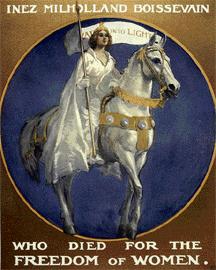 |
Inez Milholland Boissevain preparing to lead the March 3, 1913, women’s suffrage
parade in Washington, D.C. Library of Congress
|
[The following appears in the East Hampton Star dated yesterday and delivered this morning, Dec. 23.]
A Suffragist Warrior, by John Tepper Marlin
Christmas Day this year will be the 100th anniversary of a huge memorial service on Capitol Hill for Inez Milholland Boissevain, a New Yorker who died on Nov. 25, 1916. Her death played a crucial role in the passage of the 19th Amendment giving women the right to vote.
Inez was the probably the most famous American feminist alive in 1916. She led the 1913 Woman Suffrage Parade in Washington, D.C. Later that year she secretly married Eugen Boissevain, who was my mother’s uncle. It was front-page news all over the United States because feminism and marriage were then considered incompatible. The New York Times described Inez as “the fairest of the Amazons.”
She died weeks after collapsing in Los Angeles during a speech urging a vote against the re-election of President Woodrow Wilson because he opposed women’s suffrage and what was called the Susan B. Anthony Amendment. Her shocking death sparked hundreds of tributes and memorials around the country. The huge Christmas Day funeral service in the Hall of Heroes led to a White House meeting of members of the National Woman’s Party with President Wilson to urge him — in memory of Inez — to support the constitutional amendment recognizing the right of women to vote.
Wilson’s response to the delegation was condescending. He explained that it was impossible for him to hold together the southern wing of the Democratic Party if he championed a federal amendment, as they would have known if they had done their political homework. The fuming delegation went back across Lafayette Square to the Woman’s Party headquarters and decided to picket the White House every day until Wilson changed his mind.
The picketers were in due course arrested and transported to the Occoquan Women’s Workhouse in Lorton, Va. They promptly went on a hunger strike and were force-fed like geese. When descriptions of this torture were smuggled out of the workhouse, public opinion shifted decisively, and Wilson decided to support the 19th Amendment. It was passed by both houses of Congress and became law in 1920.
New Yorkers were prominent in the achievement. Elizabeth Cady Stanton and Susan B. Anthony were from the Rochester area. Inez was Brooklyn-born and Vassar-educated. Her portrait on a horse has been hung over the mantelpiece in the National Woman’s Party headquarters in Washington for nearly a century. Money to support the party came from Alva Vanderbilt Belmont, whose castle at Sands Point on Long Island is widely viewed as the model for F. Scott Fitzgerald’s “Great Gatsby” mansion.
One reason for Inez’s effectiveness was that she understood the media, as the daughter of a Lincoln Republican newspaper editor who in midcareer became wealthy by promoting underground tubes for the distribution of mail. Her father, an Irish Presbyterian, was the first treasurer of the N.A.A.C.P.
She championed the cause of the small upstart activist Delta sorority at Howard University to be represented in the women’s suffrage march when others in 1913 feared a backlash among whites in segregated Washington and the Southern states. I attended the 100th anniversary of that march three years ago. It attracted 5,000 Delta marchers from around the country, outnumbering by more than 10 to 1 representation by the traditional women’s organizations that existed in 1913.
In the wake of the defeat of the first female major-party presidential candidate in U.S. history in 2016, American women’s groups are organizing a Women’s March on Washington on Jan. 21. The urgency and passion with which Inez and her colleagues in the National Woman’s Party pursued their cause turned around the media, the public, and then the president, in that order. Remembering how women succeeded in the years 1913 to 1920 and translating that to a radically transformed media environment might be useful for those planning the 2017 march.
She championed the cause of the small upstart activist Delta sorority at Howard University to be represented in the women’s suffrage march when others in 1913 feared a backlash among whites in segregated Washington and the Southern states. I attended the 100th anniversary of that march three years ago. It attracted 5,000 Delta marchers from around the country, outnumbering by more than 10 to 1 representation by the traditional women’s organizations that existed in 1913.
In the wake of the defeat of the first female major-party presidential candidate in U.S. history in 2016, American women’s groups are organizing a Women’s March on Washington on Jan. 21. The urgency and passion with which Inez and her colleagues in the National Woman’s Party pursued their cause turned around the media, the public, and then the president, in that order. Remembering how women succeeded in the years 1913 to 1920 and translating that to a radically transformed media environment might be useful for those planning the 2017 march.
John Tepper Marlin wrote a play about the women’s suffrage movement that was staged at Rochester’s Geva Theatre in 1998 and twice at the Springs Presbyterian Church in 2005. He has lived in Springs since 1981.







